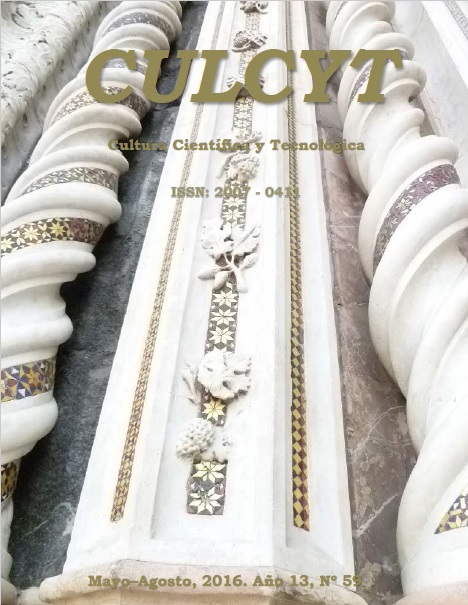Coeficiente alfa de Cronbach para medir la fiabilidad de un cuestionario difuso
Keywords:
Alfa de Cronbachl, Instrumento de medición, Escala de Likert, Números difusosAbstract
El presente trabajo consiste en determinar el coeficiente alfa de Cronbach para medir la fiabilidad de un cuestionario que emplea una escala difusa de medición de formato abierto. La versión difusa del cuestionario permite contrarrestar la limitante de lidiar con información imprecisa e incierta comúnmente encontrada en valoraciones perceptuales. Lo que permite a los respondientes expresar sus opiniones tomando rangos de acuerdo a un continuo lineal, y no a un valor único como lo hace escala de Likert. El desarrollo del coeficiente alfa de Cronbach se lleva acabo siguiendo las bases de la aritmética de números difusos. Un caso ilustrativo se presenta para demostrar la aplicabilidad del coeficiente en ambientes difusos.Downloads
References
Akdag, H., Kalayci, T., Karagöz, S., Zülfikar, H., & Giz, D. (2014). The evaluation of hospital service quality by fuzzy MCDM. Applied Soft Computing Journal, 23, 239–248. http://doi.org/10.1016/j.asoc.2014.06.033
Belén, A., Guajardo, R., José, M., López, G., & González, I. (2015). Analysis of the reliability of the fuzzy scale for assessing the students ’ learning styles in Mathematics. 9th Conference of the European Society for Fuzzy Logic and Technology, 727–733.
Chen, T., Ku, T., Chen, T. Y., Method, I., Measures, N. F., & Tfns, D. (2008). Importance-Assessing Method with Fuzzy Number-Valued Fuzzy Measures and Discussions on TFNs And TrFNs. International Journal of Fuzzy Systems, 10(2), 92–103.
Cronbach, L. J. (1951). Coefficient alpha and the internal structure of tests. Psychometrika, 16(3), 297–334. http://doi.org/10.1007/BF02310555
García-Alcaraz, J. L., Alvarado-Iniesta, A., Blanco-Fernández, J., Maldonado-Macías, A. A., Jiménez-Macías, E., & Saenz-Díez Muro, J.
C. (2015). The Impact of Demand and Supplier on Wine’s Supply Chain Performance. Journal of Food Process Engineering. http://doi.org/10.1111/jfpe.12257
Gugiu, C., Coryn, C. L. S., & Applegate, B. (2010). Structure and measurement properties of the Patient Assessment of Chronic Illness Care instrument. Journal of Evaluation in Clinical Practice, 16(3), 509–516. http://doi.org/10.1111/j.1365-2753.2009.01151.x
Ketkar, S., Kock, N., Parente, R., & Verville, J. (2012). The impact of individualism on buyer-supplier relationship norms, trust and market performance: An analysis of data from Brazil and the U.S.A. International Business Review, 21(5), 782–793. http://doi.org/10.1016/j.ibusrev.2011.09.003
Kim, Y., & Chung, E.-S. (2013). Fuzzy VIKOR approach for assessing the vulnerability of the water supply to climate change and variability in South Korea. Applied Mathematical Modelling, 37(22), 9419–9430. http://doi.org/10.1016/j.apm.2013.04.040
Kline, R. B. (2011). Principles and Practice of Structural Equation Modeling. Analysis (Third Edit, Vol. 77). New York: The Guilford Press. http://doi.org/10.1038/156278a0
Kocak, C., Egrioglu, E., Yolcu, U., & Aladag, C. H. (2014). Computing Cronbach Alpha Reliability Coefficient for Fuzzy Survey Data.
American Journal of Intelligent Systems, 4(5), 204–213. http://doi.org/10.5923/j.ajis.20140405.03
Li, Q. (2013). A novel Likert scale based on fuzzy sets theory. Expert Systems With Applications, 40(5), 1609–1618. http://doi.org/10.1016/j.eswa.2012.09.015
Likert, R. (1932). A technique for the measturement of attittudes. Archives of Psychology, 22(140), 1–55. http://doi.org/2731047
Zadeh, L. A. (1965). Fuzzy sets. Information and Control, 8(3), 338–353. http://doi.org/10.1016/S0019-9958(65)90241-X
Published
How to Cite
Issue
Section
License
Todos los contenidos de CULCYT se distribuyen bajo una licencia de uso y distribución “Creative Commons Reconocimiento-No Comercial 4.0 Internacional” (CC-BY-NC). Puede consultar desde aquí la versión informativa de la licencia.
Los autores/as que soliciten publicar en esta revista, aceptan los términos siguientes: a) los/las autores/as conservarán sus derechos de autor y garantizarán a la revista el derecho de primera publicación de su obra; y b) se permite y recomienda a los/las autores/as agregar enlaces de sus artículos en CULCYT en la página web de su institución o en la personal, debido a que ello puede generar intercambios interesantes y aumentar las citas de su obra publicada.



